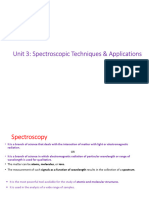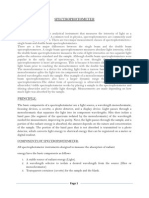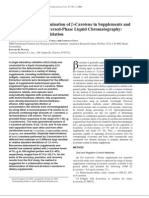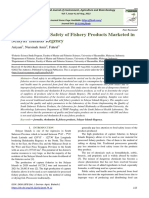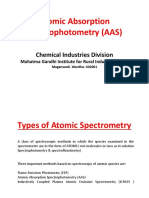0 ratings0% found this document useful (0 votes)
1 viewsInfrared spectroscopy
Infrared spectroscopy
Uploaded by
Sreejitha SriCopyright:
© All Rights Reserved
Available Formats
Download as DOCX, PDF, TXT or read online from Scribd
Infrared spectroscopy
Infrared spectroscopy
Uploaded by
Sreejitha Sri0 ratings0% found this document useful (0 votes)
1 views7 pagesCopyright
© © All Rights Reserved
Available Formats
DOCX, PDF, TXT or read online from Scribd
Share this document
Did you find this document useful?
Is this content inappropriate?
Copyright:
© All Rights Reserved
Available Formats
Download as DOCX, PDF, TXT or read online from Scribd
Download as docx, pdf, or txt
0 ratings0% found this document useful (0 votes)
1 views7 pagesInfrared spectroscopy
Infrared spectroscopy
Uploaded by
Sreejitha SriCopyright:
© All Rights Reserved
Available Formats
Download as DOCX, PDF, TXT or read online from Scribd
Download as docx, pdf, or txt
You are on page 1of 7
Infrared spectroscopy, also termed vibrational spectroscopy, is a
technique that utilizes the interaction between infrared and the
sample.
Principle of IR spectroscopy/ Vibrational
spectroscopy
The wavelength utilized for the analysis of organic
compounds ranges from 2,500 to 16,000 nm, with a
corresponding frequency range from 1.9×1013 to
1.2×1014 Hz.
These rays don’t have enough energy to excite the
electrons, but they do, however, cause the vibrational
excitation of covalently bonded atoms or groups.
The vibration observed in the atoms is characteristic of
these atoms and thus helps in the detection of the
molecules.
The infrared spectrum is the fundamental measurement
obtained in infrared spectroscopy.
The spectrum is a plot of measured infrared intensity versus
wavelength (or frequency) of light.
IR Spectroscopy measures the vibrations of atoms, and
based on this; it is possible to determine the functional
groups.
Steps of IR spectroscopy/ Vibrational
spectroscopy
The IR spectrometer is turned on and allowed to warm up for
30 minutes.
The unknown sample is taken, and its appearance is
recorded.
The background spectrum is collected to remove the
spectrum obtained from natural reasons.
A small amount of sample is placed under the probe by
using a metal spatula.
The probe is set in place by twisting it.
The IR spectrum of the unknown sample is obtained. The
process is repeated, if necessary, to get a good quality
spectrum.
The absorption frequencies that indicate the functional
groups present are recorded.
The obtained spectrum is analyzed to determine the
probable identification of the unknown sample.
Uses of IR spectroscopy/ Vibrational
spectroscopy
Infrared spectroscopy has been widely used for the
characterization of proteins and the analysis of various solid,
liquid, and gaseous samples. 4. Mass spectroscopy
Mass spectroscopy is a type of spectroscopic technique that helps
to identify the amount and type of chemicals present in the
sample by analyzing the mass to charge ratio of the ions.
Principle of Mass spectroscopy
Mass spectroscopy is based on the principle that when a
sample is bombarded with electrons, the molecules in the
compounds are ionized into ions.
The separation of ions is dependent on their mass to charge
ratio. For most ions, the charge is one which means that
the ratio is simply the molecular mass of the ion.
The ions are then subjected to electric and magnetic fields
which causes deflection of the ions. Ions with a similar
charge to mass ratio show similar deflection.
The relative abundance of each of such ions is then detected
with the help of the detectors.
The mass spectrum is formed by plotting the relative
abundance of the ions against the ratio of mass to charge.
The spectrum can then be used for the determination of the
elemental configuration of the sample, the masses of the
particle or molecules, and the chemical structure of the
sample.
Steps of Mass spectroscopy
200 µl of the sample is mixed with 1.8 ml of 65% nitric acid.
The mixture is then added to the water bath at 50°C
overnight.
The tubes are then cooled down to room temperature, and
the sample is diluted by adding 8 ml distilled water to
obtain nitric acid concentration below 20%.
The sample is then added to the spectroscope and run.
The results are obtained through the software on the
computer in the form of the mass spectrum.
Uses of Mass spectroscopy
Mass spectroscopy is a valuable tool to quantify known
materials.
It also allows the identification of unknown compounds and
determination of the structure and chemical composition of
various substances.
15. Molecular spectroscopy
Molecular spectroscopy is a type of spectroscopy that utilizes the
interaction between molecules and electromagnetic radiation to
determine the structural composition of samples.
Principle of Molecular spectroscopy
Molecular spectroscopy involves the interaction of materials
with electromagnetic radiation in order to produce an
absorption pattern (i.e. a spectrum) from which structural
or compositional information can be deduced.
The molecular spectrum is formed when the molecules move
from one energy state to another as a result of interaction
with different electromagnetic radiation.
The mechanisms involved are similar to atoms, but the
process is more complicated.
The interaction between different nuclei and electrons takes
place in molecules that are not observed in atoms.
These interactions can be electronic, rotational, or
vibrational. Based on the type of interactions, different
spectrometric techniques can be applied for the analysis of
the compounds.
Similarly, either the absorption or emission spectrum can be
utilized based on the type of interactions being exploited.
Steps of Molecular spectroscopy
Different types of spectrometer systems like emission
spectrometer and Fourier-transform spectrometer can be
used for molecular spectroscopy.
All these systems include a source of radiation, a sample,
and a system for detecting and analyzing the sample.
The sample is added to the spectrometer where the
radiation source focuses on it.
Two samples of known and unknown concentrations are
taken in a transport vessel, also termed as a cuvette.
The vessels are then placed, one after the other, in the
spectrophotometer that is provided with light source and
detectors.
The spectrophotometer is operated that passes light of a
particular wavelength through the sample.
The photosensitive detectors present in the
spectrophotometer detect the light passing through the
sample, which is then converted into digital values.
A graph of the absorbance measured against the
concentration of the sample is plotted, which can then be
used for the determination of the unknown concentration
of the sample.
Uses of Molecular spectroscopy
Molecular spectroscopy allows the analysis of the atomic and
molecular structures of various compounds.
It also helps in the determination of gas composition as well
as the composition of other compounds.
UV spectroscopy is a type of absorption spectroscopy where UV
lights are absorbed by the electrons that causes them to excite to
a high energy state.
Principle of UV spectroscopy
In UV spectroscopy, the UV rays passed to the sample are
absorbed by the electrons, which increases the energy of
the system.
This causes the excitation of an electron from a lower
energy state to a higher energy state.
This excitation forms an absorption spectrum that can be
detected by the detectors in the spectrometer.
The amount of photon (radiation) absorbed results in an
absorption spectrum which can then be measured in terms
of absorbance.
The absorbance of a sample is dependent on the number of
excited electrons which in turn is dependent on the
concentration of molecules in the sample.
Steps of UV spectroscopy
Two samples of known and unknown concentrations are
taken in a transport vessel, also termed as a cuvette.
The vessels are then placed, one after the other, in the
spectrophotometer that is provided with light source and
detectors.
The spectrophotometer is operated that passes light of a
particular wavelength through the sample.
The photosensitive detectors present in the
spectrophotometer detect the light passing through the
sample, which is then converted into digital values.
A graph of the absorbance measured against the
concentration of the sample is plotted, which can then be
used for the determination of the unknown concentration
of the sample.
Uses of UV spectroscopy
UV spectroscopy is a technique used for the detection of
impurities in organic substances.
This can also be used for the quantitative determination of
compounds that can absorb UV radiation.
It can also be used for the study of the kinetics of a reaction
where the UV rays are passed through the reaction cell,
and the changes in absorbance are studied.
21. Ultraviolet and visible (UV/Vis)
spectroscopy
Ultraviolet and visible spectroscopy is an absorption spectroscopy
technique which uses the radiation in the UV range and the
adjacent visible range of the electromagnetic radiation.
Principle of UV/Vis spectroscopy
UV/Vis spectroscopy is based on the principle that materials
produce an absorption spectrum which is a range of
absorbance resulting from the radiation absorbed by the
material at different frequencies.
The absorption spectrum of materials depends on the atomic
and molecular composition of that material.
The frequency of light radiation absorbed by a material is
dependent on the energy difference between the two
energy states of the molecules.
The absorption results in the formation of the absorption
line, which, together with other lines, form an absorption
spectrum.
The incident light in this spectrometer is in the range of UV
and visible spectrum of the electromagnetic spectrum.
Thus, when a photon with sufficient energy reaches an
object, the energy is absorbed by the electrons causing
them to bump into a higher energy state.
The amount of photon (radiation) absorbed results in an
absorption spectrum which can then be measured in terms
of absorbance.
The absorbance of a sample is dependent on the number of
excited electrons which in turn is dependent on the
concentration of molecules in the sample.
Steps of UV/Vis spectroscopy
Solvent liquid and the sample solution are taken in two
transport vessels, also termed as cuvettes.
The vessel with solvent liquid is then placed in the
spectrometer to determine the light loss due to scattering
and absorbance by the solvent. Any absorbance observed
in this process is to be subtracted from the absorbance of
the sample.
The cuvette with the sample solution is then placed in the
spectrometer.
The absorbance of the sample is noted in different
frequencies which usually ranges from 200-800 nm.
A similar spectrum is formed from the different
concentrations of the samples.
A graph of the absorbance measured against the
concentration of the sample is plotted, which can then be
used for the determination of the unknown concentration
of the sample.
Uses of UV/Vis spectroscopy
Qualitative analysis may be performed in the UV/Vis regions
to identify certain classes (proteins and nucleic acids) of
compounds both in the pure state and in biological
mixtures.
This type of spectroscopy is used for the quantification of
biological samples either directly or via colorimetric assays.
16. Mossbauer spectroscopy
Mossbauer spectroscopy is a technique based on the Mossbauer
effect discovered by Rudolf Mössbauer which utilizes the
spectrum formed by the absorption or emission of nuclear gamma
rays in solid particles.
IR spectroscopy can be used for the detection of functional
groups which helps in the identification of molecules and
their composition.
Applications of IR spectroscopic techniques allow identifying
molecular changes due to bodily changes, understanding of the
molecular mechanism of various diseases, and identifying specific
3.
spectral biomarkers that can be used in diagnosis.
Atomic absorption spectroscopy
Atomic absorption is an analytical technique utilizing the principle
of spectroscopy for the quantitative determination of chemical
elements.
Principle of Atomic absorption spectroscopy
Atomic absorption spectroscopy utilizes the principle that
free electrons generated in an atomizer absorb radiation of
different wavelengths.
The free electrons absorb UV or visible light, causing the
electrons to transfer to higher energy orbits.
During this process, the absorption spectrum is released,
which is detected by the photodetectors.
The absorption spectrum formed allows the quantification of
free electrons in the gaseous state of the matter.
The amount of photon (radiation) absorbed results in an
absorption spectrum which can then be measured in terms
of absorbance.
The absorbance of a sample is dependent on the
concentration of molecules in the sample.
Steps of Atomic absorption spectroscopy
The liquid sample is mixed with a particular volume of spirit
which is added to a flask which is then vaporized into a gas
by a fuel-rich acetylene-nitrous oxide flame.
A lamp is set with the necessary wavelength as a light
source.
The gas formed from the liquid sample is then passed
through a detector that detects the absorbance of the
atoms in the gas.
A similar process is performed for the detection of
absorbance of solvent bank and standard solution.
A graph is plotted for the absorbance against the
concentration of the molecules in the sample.
Uses of Atomic absorption spectroscopy
Atomic absorption spectroscopy can be used for the
quantitative and qualitative determination of metallic
elements in biological systems.
This also helps in the detection of metals as an impurity in
alloys and other mixtures.
Atomic absorption spectroscopy has been utilized for the
purification of environmental samples like water and soil.
Detection of metals in pharmaceutical products and oil
products can also be done by this method.
You might also like
- Experiment 2 Uv-Visible Determination of An Unknown Concentration of Kmno Solution Theory/BackgroundDocument13 pagesExperiment 2 Uv-Visible Determination of An Unknown Concentration of Kmno Solution Theory/BackgroundMuhammad Azri HaziqNo ratings yet
- Practical 1 SpectrophotometryDocument3 pagesPractical 1 SpectrophotometryhoshniNo ratings yet
- Principle of UV SpectrosDocument10 pagesPrinciple of UV SpectrosHesham AlsoghierNo ratings yet
- UV Spectroscopy - Principle, Instrumentation, Applications - Instrumentation - Microbe NotesDocument5 pagesUV Spectroscopy - Principle, Instrumentation, Applications - Instrumentation - Microbe NotesIJAJ-PHARMA TUTOR100% (3)
- tmp3588122518401173628 PrintDocument25 pagestmp3588122518401173628 Printjosephusjohn009No ratings yet
- What Is UV SpectrosDocument20 pagesWhat Is UV SpectrosSimranNo ratings yet
- Spectrophotometry and ColorimetryDocument5 pagesSpectrophotometry and ColorimetryHarish.UNo ratings yet
- Uv Visible SpectrosDocument28 pagesUv Visible Spectrosjoshishravan3003100% (1)
- Practical Lab - Finals PDFDocument8 pagesPractical Lab - Finals PDFSarmad HussainNo ratings yet
- UV SpectrosDocument4 pagesUV SpectrosCarlton GrantNo ratings yet
- Spectroscopy IntroDocument43 pagesSpectroscopy Introshruti shahNo ratings yet
- Atomic Absorption SpectrosDocument5 pagesAtomic Absorption SpectrosFrancis Oche AdahNo ratings yet
- BCH 315 First Lecture NoteDocument12 pagesBCH 315 First Lecture Notemichaelokuchukwu22No ratings yet
- Spectroscopic TechniqueDocument24 pagesSpectroscopic TechniqueJubair Al-rashidNo ratings yet
- General Spectroscopy and UV, IR, NMR Spectroscopy Questions and AnswersDocument65 pagesGeneral Spectroscopy and UV, IR, NMR Spectroscopy Questions and Answerslotus25369cnNo ratings yet
- NAME: Mahnoor Kamran Roll Number: 22-80052: Submitted To: DR - Laiba ArshadDocument29 pagesNAME: Mahnoor Kamran Roll Number: 22-80052: Submitted To: DR - Laiba Arshadtayyab malikNo ratings yet
- SpectrosDocument35 pagesSpectrosLoren Victoria AgbayNo ratings yet
- Difference Between Uv TypesDocument5 pagesDifference Between Uv TypesFrancis Oche AdahNo ratings yet
- Spectroscopy: Classification of MethodsDocument8 pagesSpectroscopy: Classification of Methodsabdulla ateeqNo ratings yet
- Instrumentation MethodsDocument42 pagesInstrumentation MethodsANZC-chetana singhNo ratings yet
- Absorption Spectroscopy Refers ToDocument12 pagesAbsorption Spectroscopy Refers ToSajid Khan SadozaiNo ratings yet
- Ultra Violet - Visible SpectrosDocument13 pagesUltra Violet - Visible SpectrosSherin SunnyNo ratings yet
- Prinsip Kerja Instrumen Spektroskopi: 1. Spektrofotometer UV-VisDocument10 pagesPrinsip Kerja Instrumen Spektroskopi: 1. Spektrofotometer UV-ViswardaNo ratings yet
- Spectroscopic TechniquesDocument20 pagesSpectroscopic Techniquesmahmoudabdelmoneim0No ratings yet
- Spectroscopy and It's TypesDocument5 pagesSpectroscopy and It's TypesMemona AkbarNo ratings yet
- Comparison Between Spectrophotometry and Spectrofluorimetry, Its Application in Agriculture and Medicine.Document8 pagesComparison Between Spectrophotometry and Spectrofluorimetry, Its Application in Agriculture and Medicine.Ayolotu Muyiwa100% (2)
- Aulia Rahmah Triastanti 4C (kimorII)Document8 pagesAulia Rahmah Triastanti 4C (kimorII)AuliaRahmahTriastantiIINo ratings yet
- UV SpectrosDocument7 pagesUV Spectrosbszool006No ratings yet
- Unit 3 Spectroscopic Tecniques and Applications2 - NotesDocument88 pagesUnit 3 Spectroscopic Tecniques and Applications2 - Notesparth.choudhari.btech2023No ratings yet
- SpectrophotometryDocument7 pagesSpectrophotometrySantanah Daxene DayloNo ratings yet
- Particle Size AnalyzerDocument14 pagesParticle Size AnalyzermmmonmissionNo ratings yet
- SpectrosDocument3 pagesSpectrosthomassreisNo ratings yet
- 88Document57 pages88Nilesh MaitiNo ratings yet
- Spectroscopy OvrviewDocument164 pagesSpectroscopy OvrviewKim Phillips100% (1)
- Mass Spectrometry InstrumentationDocument3 pagesMass Spectrometry InstrumentationSangeetha priya SNo ratings yet
- AtomicDocument3 pagesAtomicRashidNo ratings yet
- Uv-Visible SpectrosDocument22 pagesUv-Visible Spectrosmazherchemist401No ratings yet
- SpectrophotometryDocument22 pagesSpectrophotometryaziskfNo ratings yet
- Pi Unit-IiiDocument29 pagesPi Unit-IiiAnil KumarNo ratings yet
- Uv Spectroscopy 5Document11 pagesUv Spectroscopy 5Emmanuella OffiongNo ratings yet
- SPECTROPHOTOMETERDocument5 pagesSPECTROPHOTOMETERKokab KhanNo ratings yet
- Atomic SpectrosDocument23 pagesAtomic SpectrosJean Kimberly AgnoNo ratings yet
- Introduction To SpectrosDocument24 pagesIntroduction To SpectrosPIRZADA TALHA ISMAIL100% (1)
- SPECTROSCOPY Notes - 3Document7 pagesSPECTROSCOPY Notes - 3re2phukanNo ratings yet
- Gabungan EnglishDocument77 pagesGabungan EnglishRiswanda HimawanNo ratings yet
- Org ChemDocument8 pagesOrg ChemAnam MustafaNo ratings yet
- Absorption Spectroscopy Refers ToDocument8 pagesAbsorption Spectroscopy Refers TonileshbagaleNo ratings yet
- Spectroscopy and Types LectureDocument8 pagesSpectroscopy and Types LectureAnisam AbhiNo ratings yet
- Introduction To Molecular Spectroscopy: By: M.Z.IqbalDocument24 pagesIntroduction To Molecular Spectroscopy: By: M.Z.IqbalMuhammad TausifNo ratings yet
- UV VisDocument2 pagesUV Vist4424914No ratings yet
- Uv VisDocument4 pagesUv VisohoreyNo ratings yet
- Spectroscopy: Spectroscopy Is The Study of TheDocument51 pagesSpectroscopy: Spectroscopy Is The Study of ThePalwan SaryNo ratings yet
- UV Visible SpectrosDocument12 pagesUV Visible SpectrosAbdullah Bin TariqNo ratings yet
- OrbitalDocument2 pagesOrbitaladam millerNo ratings yet
- Atomic Mass SpectrosDocument40 pagesAtomic Mass Spectrosjohnpaul varonaNo ratings yet
- Spectroscopy - WikipediaDocument46 pagesSpectroscopy - WikipediaAnubhav VarshneyNo ratings yet
- Introduction To SpectrometryDocument2 pagesIntroduction To SpectrometryDumile NombasaNo ratings yet
- Photoelectron Spectroscopy: Bulk and Surface Electronic StructuresFrom EverandPhotoelectron Spectroscopy: Bulk and Surface Electronic StructuresNo ratings yet
- Application of Spectral Studies in Pharmaceutical Product development: (Basic Approach with Illustrated Examples) First Revised EditionFrom EverandApplication of Spectral Studies in Pharmaceutical Product development: (Basic Approach with Illustrated Examples) First Revised EditionNo ratings yet
- Photometry: Science, Sensitivity, and Its Connection to AstronomyFrom EverandPhotometry: Science, Sensitivity, and Its Connection to AstronomyNo ratings yet
- Jenway 7300 7305 Spectro Manual LODocument52 pagesJenway 7300 7305 Spectro Manual LOAbdulrahman Biomedical engineer100% (1)
- 2023 - Analytical Chemistry With Answers 1Document14 pages2023 - Analytical Chemistry With Answers 1sbelodoNo ratings yet
- Establishing Spectrophotometer Performance Tests: Standard Guide ForDocument9 pagesEstablishing Spectrophotometer Performance Tests: Standard Guide ForpechugonisNo ratings yet
- Beeks Document 2016Document76 pagesBeeks Document 2016Ajagwu EustaceNo ratings yet
- Beta Carotene AnalysisDocument5 pagesBeta Carotene AnalysisChandra Shekhar BNo ratings yet
- Tyros in One LabDocument13 pagesTyros in One LabCynthia Jz FdzNo ratings yet
- Method For The Determination of Beta Carotene in Supplements and Raw Materials by Reversed Phase Liquid Chromatography Single Laboratory ValidationDocument13 pagesMethod For The Determination of Beta Carotene in Supplements and Raw Materials by Reversed Phase Liquid Chromatography Single Laboratory ValidationChris JohnsonNo ratings yet
- Facile Green Fabrication of Gold Nanoparticles Using Desmostachya Bipinnata and Its Biomedical Application StudiesDocument3 pagesFacile Green Fabrication of Gold Nanoparticles Using Desmostachya Bipinnata and Its Biomedical Application StudiesInternational Journal of Innovative Science and Research TechnologyNo ratings yet
- SpectrophotometerDocument3 pagesSpectrophotometerSutan Ahmadin Erdam PanyalaiNo ratings yet
- Wave GliderDocument3 pagesWave Glidervenkatesh1992No ratings yet
- A Simple Spectrophotometric Method For Quantification of Casein in Milk and Milk ProductsDocument5 pagesA Simple Spectrophotometric Method For Quantification of Casein in Milk and Milk ProductsIJAR JOURNALNo ratings yet
- Practical 05: Use of SPECTROPHOTOMETERDocument2 pagesPractical 05: Use of SPECTROPHOTOMETERMaryam noorNo ratings yet
- Quality and Food Safety of Fishery Products Marketed in Selayar Islands RegencyDocument6 pagesQuality and Food Safety of Fishery Products Marketed in Selayar Islands RegencyMamta AgarwalNo ratings yet
- T.Y.B.Sc. (Chemistry) - 03.07.2021Document70 pagesT.Y.B.Sc. (Chemistry) - 03.07.20210508shelkeNo ratings yet
- Study of Simple Spectrophotometer Design Using LDR Sensors Based On Arduino Uno MicrocontrollerDocument7 pagesStudy of Simple Spectrophotometer Design Using LDR Sensors Based On Arduino Uno MicrocontrollerLouis aNo ratings yet
- Watts 1974 Determination of Uric Acid in Blood and in UrineDocument9 pagesWatts 1974 Determination of Uric Acid in Blood and in Urinemusembijosef2011No ratings yet
- Phychem 2 - Lab Report 2Document9 pagesPhychem 2 - Lab Report 2Ralph EvidenteNo ratings yet
- Solubility of Titanium Dioxide in Cosmetic FormulationsDocument10 pagesSolubility of Titanium Dioxide in Cosmetic FormulationsMeiNo ratings yet
- Experiment No: 4 Calibration Curve of Diclofenac Sodium: October 2018Document8 pagesExperiment No: 4 Calibration Curve of Diclofenac Sodium: October 2018Prasanga KolliNo ratings yet
- Papain ProductionDocument5 pagesPapain ProductionANDREW ONUNAKUNo ratings yet
- Colorimetry MN in SteelDocument6 pagesColorimetry MN in SteelOmSilence2651100% (2)
- Eric Ed296867Document666 pagesEric Ed296867Alfredo Hernandez100% (1)
- Product Code HSN Code Product Name Type: Analytical InstrumentsDocument2 pagesProduct Code HSN Code Product Name Type: Analytical InstrumentsDept of Biotechnology bduNo ratings yet
- Halle Spanke Lab Report 1Document5 pagesHalle Spanke Lab Report 1api-663756002No ratings yet
- IIT Bombay Lab Manual Chemical EngineeringDocument2 pagesIIT Bombay Lab Manual Chemical EngineeringAnuj SrivastavaNo ratings yet
- Molibdeno Method 8036Document8 pagesMolibdeno Method 8036angelo saldarriagaNo ratings yet
- Atomic AbsorptionDocument27 pagesAtomic Absorptionindustrial technoNo ratings yet
- Manual For Second SemDocument31 pagesManual For Second SemLohit MNo ratings yet
- Service Manual For XL600 With ISE V201201Document378 pagesService Manual For XL600 With ISE V201201Vũ Duy HoàngNo ratings yet




























